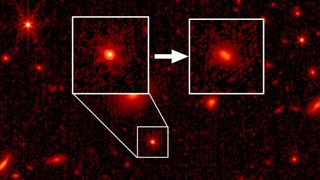Home
News
Science & Astronomy

The quasar HSC J2236+0032 as seen by the James Webb Space Telescope.
(Image credit: Ding, Onoue, Silverman, et al.)
Stars can’t hide behind the light from feeding supermassive black holes in the infant universe anymore.
With the aid of the James Webb Space Telescope (JWST), astronomers have seen starlight from two early galaxies that host feeding supermassive black holes, or quasars, for the first time. The findings could eventually help scientists better understand how supermassive black holes quickly grow to masses equivalent to millions or billions of suns and how they and the galaxies that host them evolve hand-in-hand.
“25 years ago, it was amazing to us that we were able to observe host galaxies from 3 billion years back, using large ground-based telescopes,” team member and Max Planck Institute for Astronomy researcher Knud Janke said in a statement. “The Hubble Space Telescope allowed us to probe the peak epoch of black hole growth 10 billion years ago. And now we have JWST available to see the galaxies in which the first supermassive black holes emerged.”
Related: Cosmic monsters found lurking at heart of ancient star clusters by the James Webb Space Telescope
The team observed two of these so-called active galaxies, which are seen as they were when the 13.8 billion-year-old universe was less than one billion years old. They were able to calculate both the mass of the galaxies and the mass of the supermassive black holes that are powering the quasars, designated J2236+0032 and J2255+0251. Light from these two galaxies has taken 12.9 and 12.8 billion years to reach us, thus appearing to astronomers as they were 870 and 880 million years after the Big Bang, respectively.
The observations revealed that the mass of the galaxies is 130 billion and 30 billion times that of the sun, and the masses of the monstrous feeding black holes as 1.4 billion solar masses for J2236+0032 and 200 million solar masses for J2255+0251. This showed the mass of these early galaxies and their central black holes are related in the same way seen in galaxies observed closer to the Milky Way and, thus, more recent in time.
How do supermassive black holes grow with their galaxies?
Quasars are some of the most extreme objects in the entire universe. Powered by supermassive black holes surrounded by gas and dust, some of which is accreted to the black hole, some of which is blasted out at speeds approaching that of light, quasars emit so much light they can often outshine every star in the galaxy that hosts them combined.
Almost every galaxy is believed to have a supermassive black hole at its heart, but not all of these are quasars. For example, the supermassive black hole at the center of the Milky Way, Sagittarius A* (Sgr A*), consumes so little matter it is equivalent to a human eating a grain of rice every million years. Thus, it is not feeding enough to power a quasar.
The first quasar was spotted in 1963, and since then, scientists have unraveled the processes that power their immense emission of light. In the 2000s, it was discovered that the masses of galaxies and their supermassive black holes are related, with the mass of stars in a galaxy around 1000 times greater than the mass of its central black hole.
The relationship between the masses of supermassive black holes and their galaxies holds for galaxies with supermassive black holes with masses millions of times that of the sun and for those with central black holes billions of times the mass of our star.
The connection between the mass of galaxies and the mass of their supermassive black holes may be related to the fact that both grow via a chain of mergers between galaxies that eventually leads to the black holes at the heart of those galaxies violently colliding with each other and creating an even larger black hole. Consequently, after numerous mergers, the mass of a galaxy will be around the average mass of the initial galaxy times the number of galaxies it merged with, while the central black hole mass will be around the mass of the initial black hole times the same number, leading to a roughly linear relationship.
Another suggestion is that when a supermassive black hole feeds on enough material to become a quasar, the radiation it blasts out regulates the material available for both powering the quasar and for forming new stars. Thus when the quasar runs out of food and stops growing, star formation also slows in that galaxy.

The supermassive black hole at the center of the Milky Way, Sagittarius A* (Sgr A*), as imaged by the Event Horizon Telescope in 2017 and released in 2022. (Image credit: EHT Collaboration.)
Whatever the cause of this relationship, astronomers have been unable to determine if it exists for galaxies and their supermassive black holes in the very early universe until now. This is because, while the brightness of quasars allows them to be studied at distances of billions of light-years away, it also makes the observation of dimmer starlight from quasar-hosting galaxies challenging.
Ground-based telescopes struggle to distinguish the light from quasars and the light from stars in their galaxies due to the effect of Earth’s atmosphere. From its position above the atmosphere, the Hubble Space Telescope has had some success in unraveling the light from these galaxies when they are around 10 billion light-years away. But to do this for more distant and earlier galaxies, astronomers have had to wait for the most powerful space telescope ever placed in orbit, the JWST.
The quasars J2236+0032 and J2255+0251 were observed with the JWST’s main instrument, the Near Infrared Camera (NIRCam), for 2 hours at two different wavelengths. The team took this combined spectrum of quasar light and starlight for both galaxies and then separated out the quasar light to see the light from early stars in such galaxies for the first time.
Remarkably, observations of J2236+0032 and J2255+0251 and their galaxies with the JWST have shown that the supermassive black hole/ galaxy mass relationship exists even in the early universe. Currently, this data alone isn’t enough to reveal the origins of this mass relationship and how supermassive black holes grow to such tremendous sizes, but it will inform future investigations.
The findings represent just part of the JWST’s observations of distant quasars, with the powerful space telescope currently observing a further ten of these supermassive black hole-powered objects and their galaxies. Additionally, a further 11 hours of observation time has been granted to this specific exploration of the early universe.
The research was published on June 28 in the journal Nature.
Join our Space Forums to keep talking space on the latest missions, night sky and more! And if you have a news tip, correction or comment, let us know at: [email protected].
Breaking space news, the latest updates on rocket launches, skywatching events and more!
Robert Lea is a science journalist in the U.K. whose articles have been published in Physics World, New Scientist, Astronomy Magazine, All About Space, Newsweek and ZME Science. He also writes about science communication for Elsevier and the European Journal of Physics. Rob holds a bachelor of science degree in physics and astronomy from the U.K.’s Open University. Follow him on Twitter @sciencef1rst.
>>> Read full article>>>
Copyright for syndicated content belongs to the linked Source : Space.com – https://www.space.com/james-webb-space-telescope-quasar-early-universe































